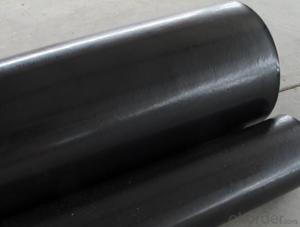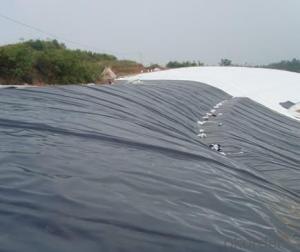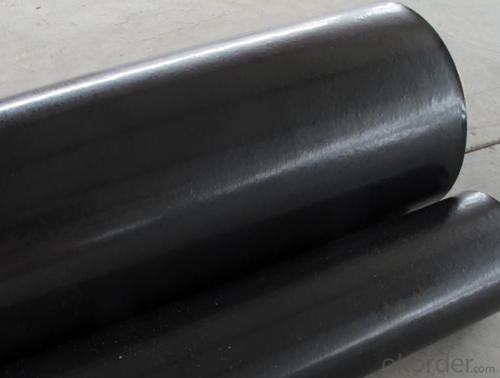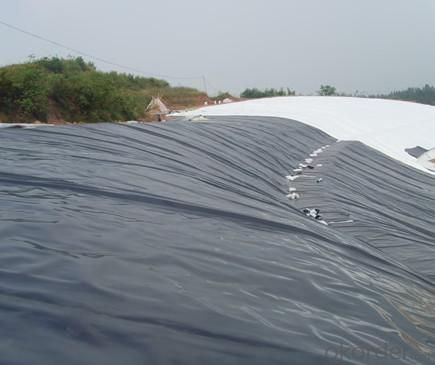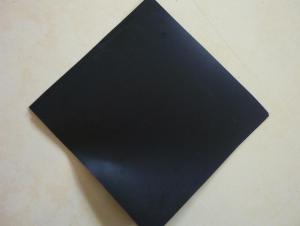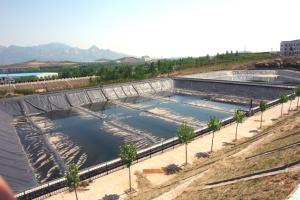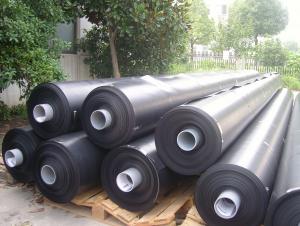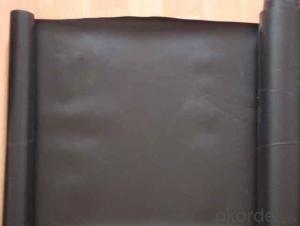LDPE Geomembranes
- Loading Port:
- China Main Port
- Payment Terms:
- TT OR LC
- Min Order Qty:
- -
- Supply Capability:
- -
OKorder Service Pledge
OKorder Financial Service
You Might Also Like
LDPE Geomembranes
Products Description
This product is extruded PE membrane formed by adding anti- oxidant, absorbent of ultraviolet and dyestuff into HDPE or LDPE or EVA and will provide an effective barrier to of liquid
water and water vapor.
Characteristics
·HDPE performs well in mechanical properties ,ageing-resistance , chemical-resistance ,climate- resistance and
resistance to puncture .
·LDPE & EVA feathers great elongation, good flexibility at low temperature, softness and easy
installation.
·ECB ,high-class waterproofing rolls, is formed by combining ethylene polymer with oil-resin.
Products Specification
Name | Thickness(mm) | Width(m) |
HDPE | 0.75-2.5 | 4-8 |
LDPE | 0.2-2.5 | 4-8 |
EVA | 0.2-2.5 | 2-8 |
ECB | 1.0-2.0 | 2-8 |
Features:
1.All physical factors such as anti-draw, anti-tear, and anti-stab meet the requirement of water works, chemicals, tunnels,
and transportation project in most conditions.
2.Good aging, durable performance, and wide temperature range, it can be useful over
thirty years on the condition of -60æ«60æ.
3.Anti-stab and fine friction factors.
4.Canker proof, acid and alkali proof, untoxic.
5.Lower cost per unit area, cost is 1/3«1/2 lower than that of PVC film, glass and cloth.
6.Convevient to install and dependable effect.
Application Rage
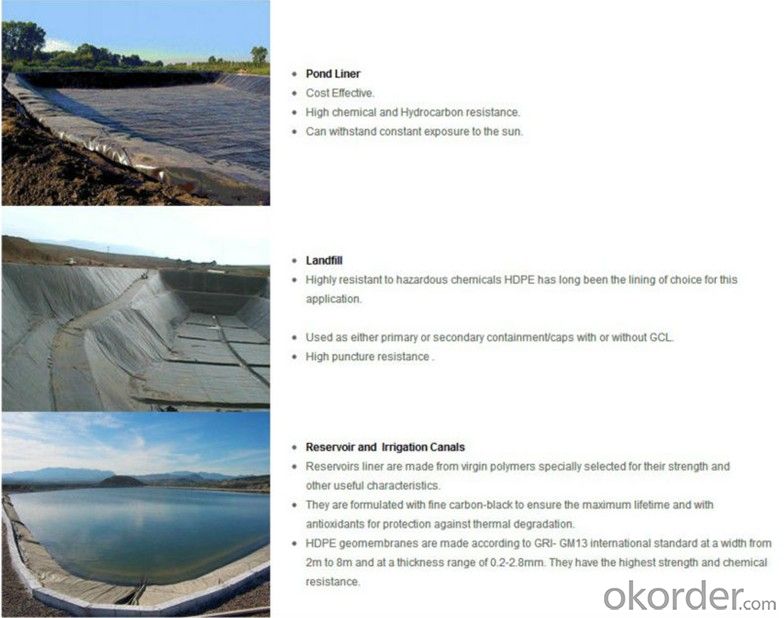
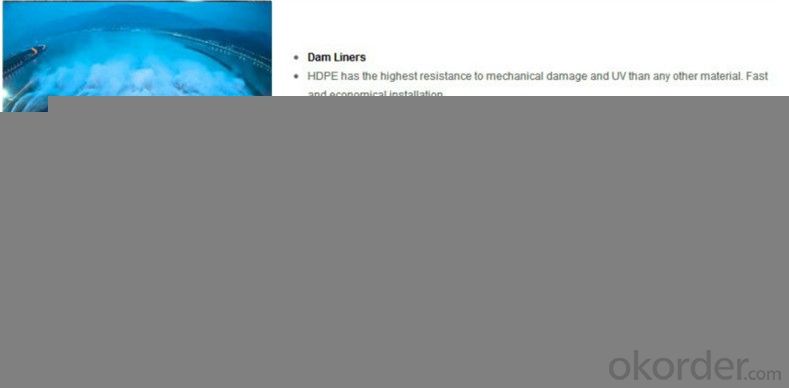
- Q: Is a waterproofing membrane resistant to rodent or insect infestation?
- Yes, a waterproofing membrane can be resistant to rodent or insect infestation. Most waterproofing membranes are made of materials that are not attractive to rodents or insects, such as bitumen or synthetic polymers. Additionally, these membranes are typically installed in a way that leaves no gaps or openings for pests to enter. However, it is important to note that no waterproofing system is completely immune to infestation. If there are pre-existing entry points or if the membrane is damaged or improperly installed, rodents or insects may still be able to penetrate the waterproofing system. Regular inspection and maintenance are crucial to ensure the integrity of the waterproofing membrane and prevent any infestation from occurring.
- Q: Can a waterproofing membrane be used on rubber surfaces?
- Yes, a waterproofing membrane can be used on rubber surfaces. Waterproofing membranes are designed to create a barrier that prevents water from penetrating and damaging the underlying surface. Rubber surfaces, such as roofs, decks, or even rubber flooring, can benefit from the application of a waterproofing membrane to protect them from water damage. The membrane is typically applied as a liquid or a sheet, and it adheres to the rubber surface, forming a protective layer that prevents water from seeping through. This can help to extend the lifespan of the rubber surface and prevent issues such as leaks or decay caused by moisture. However, it is important to ensure that the waterproofing membrane is compatible with rubber and the specific type of rubber surface being treated, as some membranes may not adhere properly or may cause damage to certain types of rubber. It is always recommended to consult with a professional or the manufacturer of the waterproofing membrane to ensure proper application and compatibility.
- Q: Can a waterproofing membrane be used for underground electrical vaults?
- Yes, a waterproofing membrane can be used for underground electrical vaults. Waterproofing membranes are commonly used to protect underground structures from water infiltration, including electrical vaults. The membrane acts as a barrier to prevent water from seeping into the vault, which can help to protect the electrical equipment and prevent damage or malfunction.
- Q: Are waterproofing membranes resistant to chlorine exposure?
- Waterproofing membranes can vary in their resistance to chlorine exposure. Some membranes are specifically designed to be resistant to chlorine and are commonly used in applications where chlorine exposure is expected, such as pool decks or water treatment facilities. These membranes are typically made with materials like PVC or TPO that have inherent resistance to chlorine and can withstand prolonged exposure without significant degradation. However, it is important to note that not all waterproofing membranes are chlorine-resistant. Some membranes, particularly those made with materials like EPDM or bitumen, may not be as resistant to chlorine and may experience deterioration or damage when exposed to chlorine for extended periods. To ensure the longevity and effectiveness of a waterproofing membrane in a chlorine-rich environment, it is crucial to select a membrane that is specifically designed and tested for chlorine resistance. Consulting with a waterproofing professional or manufacturer can help determine the most suitable membrane for the specific chlorine exposure conditions.
- Q: Can a waterproofing membrane be used on below-grade foundations?
- Indeed, below-grade foundations can benefit from the application of a waterproofing membrane. It is highly advisable to utilize this method in order to avert water penetration and safeguard the foundation against moisture-related harm. By acting as a barrier, the membrane effectively obstructs the infiltration of water into the foundation walls, thus preventing complications like leaks, mold growth, and structural deterioration. Moreover, waterproofing membranes are specifically designed to endure the elevated water pressure commonly encountered in below-grade surroundings, rendering them an optimal choice for shielding foundations in basements and other below-ground edifices.
- Q: Can waterproofing membranes be used on concrete floors?
- Indeed, concrete floors can benefit from the utilization of waterproofing membranes. Within construction, these membranes hold a prevalent role in averting water infiltration and safeguarding the underlying structure. By implementing them onto concrete floors, a protective barrier arises, effectively thwarting water from permeating and causing harm. Significantly beneficial, waterproofing membranes prove their worth in spaces prone to water exposure, such as basements, bathrooms, and outdoor patios. Their presence ensures the concrete floor's durability while defending against moisture-related predicaments like cracking, spalling, and mold development.
- Q: How thick is a typical waterproofing membrane?
- A typical waterproofing membrane is usually between 1 to 2 millimeters thick.
- Q: Can a waterproofing membrane be used on gypsum block surfaces?
- Yes, a waterproofing membrane can be used on gypsum block surfaces. Gypsum blocks are porous materials that can absorb moisture and are not naturally waterproof. Applying a waterproofing membrane can help to prevent water infiltration, moisture damage, and mold growth on the gypsum block surfaces. It creates a barrier that repels water and prevents it from seeping into the material. However, it is important to ensure that the waterproofing membrane is suitable for use on gypsum blocks and is compatible with the specific type of gypsum block being treated. Additionally, proper surface preparation and application techniques should be followed to ensure the effectiveness and longevity of the waterproofing membrane.
- Q: Can a waterproofing membrane be used on plastic block surfaces?
- Indeed, it is possible to utilize a waterproofing membrane on surfaces composed of plastic blocks. These membranes are specifically engineered to serve as a safeguard against moisture, effectively hindering water infiltration. Similar to any other type of surface, plastic blocks are prone to water-related harm if not adequately shielded. By applying a waterproofing membrane, one can successfully seal and safeguard the plastic blocks, thus thwarting water permeation and potential destruction. To achieve optimal outcomes, it is crucial to select a waterproofing membrane that harmonizes with plastic materials and adhere to the manufacturer's application guidelines.
- Q: Can a waterproofing membrane be certified or approved by industry organizations?
- Yes, a waterproofing membrane can be certified or approved by industry organizations. There are various industry organizations and standards bodies that evaluate and certify building materials and products, including waterproofing membranes. These certifications or approvals ensure that the membrane meets specific quality and performance standards set by the industry. Industry organizations such as the International Organization for Standardization (ISO), Underwriters Laboratories (UL), and the American Society for Testing and Materials (ASTM) often provide certifications or approvals for waterproofing membranes. These certifications involve rigorous testing and evaluation of the membrane's physical properties, such as its ability to resist water penetration, durability, and compatibility with other building materials. Certifications or approvals from industry organizations provide assurance to consumers, architects, contractors, and building owners that the waterproofing membrane has undergone testing and meets recognized standards for quality and performance. They also help in building code compliance and may be required for certain projects. It is always advisable to look for waterproofing membranes that have been certified or approved by reputable industry organizations to ensure that you are using a reliable and effective product for your waterproofing needs.
Send your message to us
LDPE Geomembranes
- Loading Port:
- China Main Port
- Payment Terms:
- TT OR LC
- Min Order Qty:
- -
- Supply Capability:
- -
OKorder Service Pledge
OKorder Financial Service
Similar products
Hot products
Hot Searches
Related keywords
